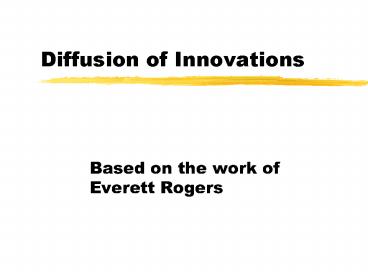Diffusion of Innovations - PowerPoint PPT Presentation
1 / 11
Title:
Diffusion of Innovations
Description:
Diffusion of Innovations Based on the work of Everett Rogers Elements The Innovation Communication Time Social System VoIP - Voice over Internet Protocal The ... – PowerPoint PPT presentation
Number of Views:462
Avg rating:3.0/5.0
Title: Diffusion of Innovations
1
Diffusion of Innovations
- Based on the work of Everett Rogers
2
Elements
- The Innovation
- Communication
- Time
- Social System
3
VoIP - Voice over Internet Protocal
http//www.fcc.gov/voip/
4
The Innovation
- Relative Advantage
- Compatibility
- Trialability
- Observability
5
Communication
The Innovation
The Potential User
The User
- Similarity of User and Potential User
- Beliefs
- Status
- Education
- Method of Communications
- Person to person or Mass communication
6
Time
- Between introduction and decision
- Personalities
- Innovators (seek out ideas)
- Early adopters (open to change)
- Early majority (ahead of the curve)
- Late majority (adopt skeptically)
- Laggards (traditionalists)
- Rate of adoption
7
The Adoption Curve
Innovation 3
Innovation 2
Percent of Adoption
Innovation 1
Time gt
Adapted from Rogers, Diffusion of Innovations,
4th Ed., p. 11
8
The Awareness-Knowledge Relationship
Laggards Late Majority Early Majority Early
Adopters Innovators
Awareness
Percent of Population
Adoption
Time gt
Adapted from Rogers, Diffusion of Innovations,
4th Ed., p. 200
9
Adoption Categories
Adapted from Rogers, Diffusion of Innovations,
4th Ed., p. 262
10
Rogers, Diffusion of Innovations, 4th Ed., p. 163
11
Social System
- Social Structure
- People with Influence
- Opinion leaders within the system
- External change agents
- Consequences
- Good/bad, Direct/indirect, intended/unintended
- Method of Decision Making in Organization
- Organizational Structure
- Centralization, Size, Openness, Complexity, etc.
See table on p. 53 of Lundblad article

